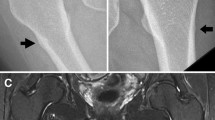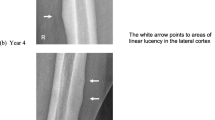Abstract
Summary
We report the case of a 53-year-old female, treated by bisphosphonate for 12 years, who presented atraumatic fractures of both fibulas. Her X-rays showed bilateral distal fibula fractures with radiological features similar to atypical femur fractures. The distal fibula should be considered as a potential site for stress fractures in bisphosphonate users.
Bisphosphonates are the most widely used drugs in the treatment of osteoporosis. During the last decade, the occurrence of atypical fractures, mostly subtrochanteric and diaphyseal femoral fractures, has been acknowledged in patients with long-term use of bisphosphonates. We report the case of a 53-year-old female on alendronate therapy for the past 12 years who presented with a few months history of atraumatic right, and subsequently left, lateral ankle pain. Her X-rays showed bilateral distal fibula fractures with radiological features similar to atypical femur fractures. She had been treated conservatively with walking boots and her treatment with bisphosphonate had been stopped 5 months prior to the fractures. Callus was progressively seen on serial follow-up X-rays, and both fractures healed completely within a reasonable period of 1 year. Investigations did not reveal any secondary causes of osteoporosis or metabolic bone disorders. To our knowledge, this is the first reported case of bilateral distal fibula fractures in a patient on long-term bisphosphonate therapy.


Similar content being viewed by others
References
Shane E, Burr D, Abrahamsen B et al (2013) Atypical subtrochanteric and diaphyseal femoral fractures: second report of a task force of the American society for bone and mineral research. J Bone Miner Res 29:1–23. doi:10.1002/jbmr.1998
Schilcher J, Michaëlsson K, Aspenberg P (2011) Bisphosphonate use and atypical fractures of the femoral shaft. N Engl J Med 364:1728–1737. doi:10.1056/NEJMoa1010650
Meier RPH, Perneger TV, Stern R et al (2012) Increasing occurrence of atypical femoral fractures associated with bisphosphonate Use. Arch Intern Med. doi:10.1001/archinternmed.2012.1796
Black DM, Cummings SR, Karpf DB et al (1996) Randomised trial of effect of alendronate on risk of fracture in women with existing vertebral fractures. Fract Int Trial Res Group Lancet 348:1535–1541
Chesnut CH III, Skag A, Christiansen C et al (2004) Effects of oral ibandronate administered daily or intermittently on fracture risk in postmenopausal osteoporosis. J Bone Miner Res 19:1241–1249. doi:10.1359/JBMR.040325
Harris ST, Reginster JY, Harley C et al (2009) Risk of fracture in women treated with monthly oral ibandronate or weekly bisphosphonates: the eValuation of IBandronate Efficacy (VIBE) database fracture study. Bone 44:758–765. doi:10.1016/j.bone.2009.01.002
McClung MR, Geusens P, Miller PD et al (2001) Effect of risedronate on the risk of hip fracture in elderly women. Hip intervention program study group. N Engl J Med 344:333–340. doi:10.1056/NEJM200102013440503
Black DM, Delmas PD, Eastell R et al (2007) Once-yearly zoledronic acid for treatment of postmenopausal osteoporosis. N Engl J Med 356:1809–1822. doi:10.1056/NEJMoa067312
Lyles KW, Colón-Emeric CS, Magaziner JS et al (2007) Zoledronic acid and clinical fractures and mortality after hip fracture. N Engl J Med 357:1799–1809. doi:10.1056/NEJMoa074941
Odvina CV, Zerwekh JE, Rao DS et al (2005) Severely suppressed bone turnover: a potential complication of alendronate therapy. J Clin Endocrinol Metab 90:1294–1301. doi:10.1210/jc.2004-0952
Imai K, Yamamoto S, Anamizu Y, Horiuchi T (2007) Pelvic insufficiency fracture associated with severe suppression of bone turnover by alendronate therapy. J Bone Miner Metab 25:333–336. doi:10.1007/s00774-007-0771-y
Breglia MD, Carter JD (2010) Atypical insufficiency fracture of the tibia associated with long-term bisphosphonate therapy. JCR: J Clin Rheumatol 16:76–78. doi:10.1097/RHU.0b013e3181cf3e3d
Tan SHS, Saseendar S, Tan BHM et al (2014) Ulnar fractures with bisphosphonate therapy: a systematic review of published case reports. Osteoporos Int. doi:10.1007/s00198-014-2885-0
Waterman GN, Yellin O, Jamshidinia K et al (2011) Metatarsal stress fractures in patients with multiple myeloma treated with long-term bisphosphonates: a report of six cases. JBJS Case Connect Os 93:e106–e106. doi:10.2106/JBJS.J.00455
Kazimoglu C, Karapinar H, Sener M, Bozkurt A (2009) Bilateral stress fractures of the distal fibula in a woman with osteoporosis: a case report. J Am Podiatr Med Assoc 99:61–64
Allen MR, Iwata K, Phipps R, Burr DB (2006) Alterations in canine vertebral bone turnover, microdamage accumulation, and biomechanical properties following 1-year treatment with clinical treatment doses of risedronate or alendronate. Bone 39:872–879. doi:10.1016/j.bone.2006.04.028
Tang SY, Allen MR, Phipps R et al (2009) Changes in non-enzymatic glycation and its association with altered mechanical properties following 1-year treatment with risedronate or alendronate. Osteoporos Int 20:887–894. doi:10.1007/s00198-008-0754-4
Saita Y, Ishijima M, Mogami A et al (2014) The fracture sites of atypical femoral fractures are associated with the weight-bearing lower limb alignment. Bone 66:105–110. doi:10.1016/j.bone.2014.06.008
Wang Q, Whittle M, Cunningham J, Kenwright J (1996) Fibula and its ligaments in load transmission and ankle joint stability. Clin Orthop Relat Res 261–270
Eriksen EF, Díez-Pérez A, Boonen S (2014) Update on long-term treatment with bisphosphonates for postmenopausal osteoporosis: a systematic review. Bone 58:126–135. doi:10.1016/j.bone.2013.09.023
Acknowledgments
The authors thank Mrs. Alexandra Godbout and Mrs. Julie Parrot for assistance in the manuscript preparation.
Author information
Authors and Affiliations
Corresponding author
Ethics declarations
Conflict of interest
Jean-Christophe Murray, Marie-Claude Audet, Martin Bédard, and Laëtitia Michou declare that they have no conflict of interest.
Rights and permissions
About this article
Cite this article
Murray, J.C., Audet, M.C., Bédard, M. et al. Bilateral distal fibula fractures in a woman on long-term bisphosphonate therapy. Osteoporos Int 27, 833–836 (2016). https://doi.org/10.1007/s00198-015-3396-3
Received:
Accepted:
Published:
Issue Date:
DOI: https://doi.org/10.1007/s00198-015-3396-3




